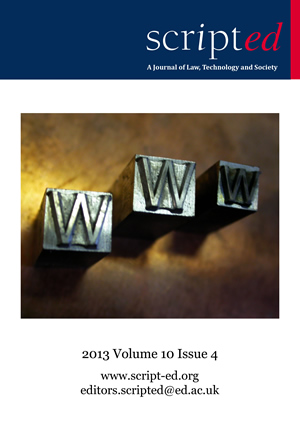(2013) 10:4 SCRIPTed 409–493
Issue DOI: 10.2966/scrip.100413

Cover image
- World Wide Web Analogic
Anna-Maria Lopez LopezA vintage style shot of three old movable type printer characters showing a contemporary concept World Wide Web (WWW). A traditional communication medium with the digital communication concept joined together by the camera.
Editorial
SCRIPTed: News and Reflection
Aisling McMahon and Laura Downey, pp.409-410
HTML | PDF
This issue marks the final issue of the tenth volume of SCRIPTed, and with the tenth anniversary approaching, we would like to take this opportunity to briefly reflect on the journal.
Reviewed Articles
The (Non) Convergence of Copyright Policies – A Quantitative Approach to Convergence in Copyright
Simone Schroff, pp.411-434
HTML | PDF
In the literature on copyright evolution, it has been argued that some degree of convergence has occurred over time. This means that the respective policies of different jurisdictions have become increasingly similar, not only in the substantive provisions themselves (the scope of protection) but also in how copyright is perceived (the copyright culture). Copyright culture in particular refers to the well-established, idealised models of author rights generally associated with civil law systems and common law copyright. Nonetheless, recent technological challenges have highlighted the significant differences that remain in how copyright responds to new challenges. This article examines the convergence of copyright policies in the US, UK, Germany and international level between 1880 and 2010. Rather than relying on a qualitative analysis, a quantitative approach is used to examine the evidence for convergence. It compares the laws as they are in force for each of the jurisdictions examined, to the two ideal types relied upon by the legal literature: author rights systems and common law copyright systems. Ideal types reflect the epitomised description of what an author rights and a common law system are, irrespective of whether these exist or have existed in such a form in the real world. These two polar opposites are used as external benchmarks against which the copyright policies are compared and the position of these policies on a spectrum which has author rights at one end and common law copyright at the other, is determined. By placing the case studies on a spectrum, their evolution relative to each other is clear and the existence of convergence and its extent can be analysed. The article concludes by clarifying the extent of convergence. The degree of convergence has been limited between the US, UK and international level, while Germany’s policies actually moved away from them. In addition, the commonly identified causal factors, such as technology and international agreements, only developed a limited impact in practice, explaining why the empirical evidence has failed to show the expected convergence.
Informed Consent in Social Media Use – The Gap between User Expectations and EU Personal Data Protection Law
Bart Custers, Simone van der Hof, Bart Schermer, Sandra Appleby-Arnold, Noellie Brockdorff, pp.435-457
HTML | PDF
In this paper, user expectations with regard to privacy and consent when using social media are compared with the EU legal framework for personal data protection. This analysis is based on a set of criteria for informed consent distilled from an analytical bibliography. User expectations regarding these criteria are derived from survey results. For each of the criteria for informed consent it is assessed whether there exists legal provisions in the existing EU personal data protection law and in the proposed legal framework in this area. A gap analysis between user expectations regarding each criterion and the availability or absence of related legal provisions shows that many but not all aspects of consent are addressed in both the current and the proposed legislation. Furthermore, the EU personal data protection legislation only provides a very general scope regarding consent and does not contain many details on what adequate consent procedures should look like. There is, at some points, a disconnect between the abstract legal provisions and the concrete practical implementations in the architecture and privacy statements of social media. Suggestions for solving these disconnects are made by suggesting changes at a practical level, by adjusting the legal framework, or both. Finally, the limits of the current models for personal data protection and consent are discussed.
On The Applicability of the Consumer Protection Code to Cloud Computing Transactions in Brazil
Clarice Castro, Chris Reed and Ruy de Queiroz, pp.458-477
HTML | PDF
We examine some important issues and concepts of the Consumer Protection Code (in Portuguese, CDC) and the difficulties of applying them to cloud computing contracts offered in Brazil. The main conclusion is that the Brazilian current consumer law offers important difficulties in relation to the interpretation of some concepts, such as the concept of “remuneration” present in the definition of “service”. By raising a discussion on the legislative lacunae in relation to a new reality present in cloud transactions involving consumers that use free cloud services for both personal and later professional interests, i.e. “prosumers”, the paper aims to offer suggestions which can help the legislators or even judges to overcome the risks of leaving this cloud computing sector far from the protective rules of a consumer rights’ code.
Reports
Exploiting Existing Data for Health Research: Conference Report
Nayha Seithi, pp.478-479
HTML | PDF
Edinburgh Biomedical Ethics Film Festival 2013 on Cyborg-Ethics
Prof. Calum MacKellar, pp.480-483
HTML | PDF
“Information and Communications Technology for Environmental Regulation: Developing a Research Agenda”: Workshop Report
Dr. Su-Ming Khoo & Dr. Kieran Hickey, pp.485-489
HTML | PDF
Book Reviews
Television Courtroom Broadcasting: Distracting Effects and Eye-tracking
By Paul Lambert
Reviewed by Yolande Stolte, pp.489-490
HTML | PDF
Relocating the Law of Geographical Indications
By Dev Gangjee
Reviewed by Pankaj Musyuni, pp.491-493
HTML | PDF